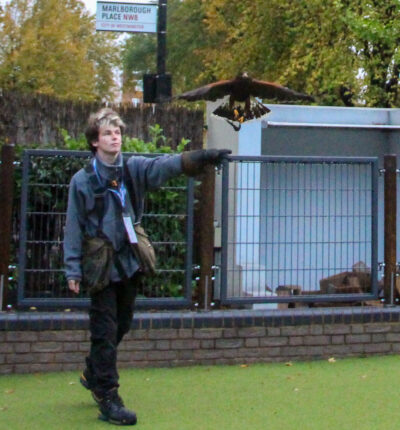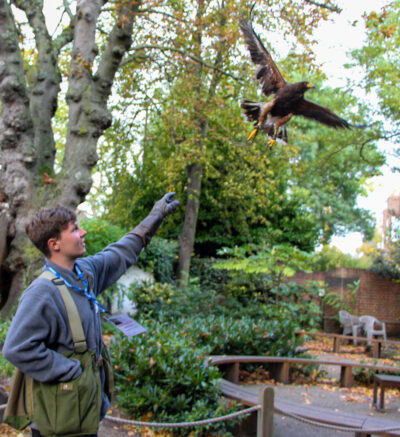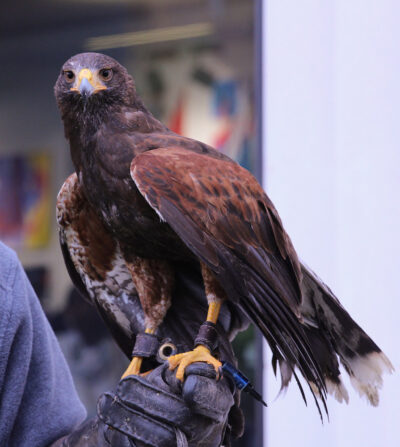
Sniper, a 10-year-old hawk, soared through the dark cold morning on October 20 with no students in sight. There was a slight drizzle of rain, but it didn’t distract the determined Harris’s hawk. Thomas Marshall, his owner, led Sniper through the surrounding areas of the school. Pigeons and other garden birds lurked in the bushes and trees, but they sensed Sniper’s presence and were scared away. The hope is that the danger that Sniper creates for the pigeons means that they will nest elsewhere.
Various Harris’s hawk birds have been brought onto campus to scare off the nesting pigeons that have settled all over the school. Pigeon eggs, waste, and their presence have been distracting and dangerous factors that have caused the school to bring London Falconry to routinely scare pigeons away, starting on October 18. This procedure had been going on for a week but would keep going for as long as it takes for the birds to be scared away.
Initially, the hawks were brought in because of an ongoing pigeon issue around the campus. Everyday, pigeons have disrupted the school and students with the mess they leave behind. Gavin Hughes, the Building Maintenance Manager, originally came up with the idea to bring in a hawk as the solution. “It [pigeon waste] was in great enough quantity that it was a bit of a slip hazard, so I brought in a pest control company to start putting in some barriers and netting to try and prevent pigeons,” he said.
This attempt failed because instead of solving the issue, the problem was being moved around to different parts of the school. Previously, the school had tried to net the building to prevent the pigeons from coming in, but that was taken down due to its appearance. They have also tried putting up fake birds of prey to intimidate the pigeons, but they had become aware that they couldn’t move and ignored the figures. Hughes tried to consider other methods to fix the problem. “There was just something in the back of my mind. I must have seen a documentary or I support a team that has got a big stadium and they have hawks to get rid of pigeons nesting so that the birds don’t nest in the stadium and make a mess.”
The idea of using a more natural method to solve the issue with hawks and falcons stuck with Hughes, and he got in touch with London Falconry, a company that does pest control jobs, goes around schools to do shows, and does film projects. Various Falconers have come with different hawks to the school.
On October 20, Sniper arrived at the school. His owner, Marshall, explained that Sniper is a Harris’s hawk, a South American bird. He is captive-bred and is a rescue bird. When Sniper was taken in by Marshall, his feathers weren’t in good condition and he wasn’t very fit, so for the past year Sniper has been doing pest control. “We’ve basically had to teach him how to be a hawk.”
Marshall also went on to explain why hawks can scare pigeons away. Hawks and birds of prey are by nature, predators, while pigeons are prey animals. When a pigeon spots a predator like a hawk, they will recognize they are in an unsafe environment. Therefore, when Sniper flies around the school buildings, the pigeons believe that it must be his territory, and they realize they can’t put a nest down because it’s unsafe. Marshall adds that the trained hawks never kill or physically attack the prey, but simply just show their presence.

Though this method of pest control has worked quickly in some cases, it has taken longer for others. Pigeons are smart animals and surprisingly maternal. So it takes an intensive visit of around two weeks to establish territory and remove any pigeons that don’t have a nest. Legally, London Falconry can remove any pigeon nests because pest species like pigeons are unprotected. The process can vary from weeks to months.
A factor that is important to successfully remove pests is down to the hawks’ weight. Sniper is one pound and four and a quarter ounces. If Marshall was to push his weight up to one pound five ounces, Sniper would not be interested in flying because his weight would be too heavy to carry. If he were to drop his weight to one pound three and a half ounces, Sniper would go find his own food because Marshall would not be providing enough. “So, we find that happy medium right in the center, where he’s happy enough to fly but not unhappy enough to go out of his way to hunt anything,” Marshall said.
These hawks not only do pest control against pigeons but can also do other types of birds. Crows can be a challenge because of their aggression, and parakeets are very invasive. Seagulls are also a common bird that hawks perform pest control on. Many smaller garden birds also lurk in trees around the campus. Unlike the pigeons, Marshall explained that they don’t get as bothered by the hawks. “What tends to happen is they will just sort of go from tree to tree, bush to bush, and sort of let you know they’re not very happy, but it doesn’t really clear them off, they know that they are far too small for him [Sniper] to sort of consider them as a meal.”
This variety of birds has made London Falconry perform jobs all over London and some parts of southeast England. Marshall has gone with Sniper to Southampton and Cambridge.
For Falconers, the ideal hawk for pest control is a Harris’s hawk. This is due to their size, and the male Harris’s hawks fit the criteria perfectly. “So with birds of prey, the females are always bigger, and because of the size difference, the females tend to be a little bit more switched on to hunt. So we tend to keep them away from any pest control just so we don’t end up accidentally killing the pigeons,” said Marshall.
He also adds that the female Harris’s hawks may mistake small dogs as prey due to their size. With Harris’s hawks, they are the most social bird of prey. Instead of only finding one mate during the breeding season to stick to for life, Harris’s hawks can be compared socially with a wolf pack. Their social element means they are easier and more relaxed in captivity.
Additionally, Sniper is very comfortable with people and is not disturbed. This is due to the shows he has been to, including birthday parties and productions. “He’s relatively relaxed 90 percent of the time,” Marshall said.

This socialness coming from Harris’s hawks has made it easier for Marshall to care for them. Sniper lives with Marshall in his garden, therefore he is caring for Sniper all day.
Though the hawks are able to fly where they want, they are so well trained that they never feel the need to fly away. This is all because of the food provided. Marshall explained that Sniper doesn’t feel a need to leave because the guaranteed food that they provide him with is more reliable than having to go hunt for himself. If a hawk were to hunt rather than be given immediate food, it would take up a lot more energy.
Harris’s hawks are also the ideal bird used because of their stellar vision and hearing. Marshall said, “he can see eight to 10 times further than I can, and he can see twice the detail.”
This comes in handy when Marshall is in a more crowded and heavily wooded area. Though the human eye may not see pigeon in the midst, Sniper is able to shake his tail to show Marshall that they are there. Their social life implements the shake of the tail because it’s a way to communicate between the birds.
This behavior can also be seen on campus, with certain areas fuller with nature and better hiding spots for pigeons than others. Sniper first started by flying to different points on the playground, and slowly moved around the building to the lower school area. Marshall is able to let Sniper go by showing him a bit of food and flicking his wrist to release the straps attached to Sniper. This routine is repeated until the intense session is over, and it helps Sniper to develop the routine.
Falconers will continue to come to campus around once a week for a couple of months, said Hughes. The length of the pest control depends on the success and outcome. The falconers will come when the school is quiet in the morning. Hughes said that the hawks came previously during recess where lots of children were distracting it, and potential injuries towards the bird wouldn’t be good.
Hughes noted that if there is an intensive spot where the birds seem to stay, he will work with falconers to get them out, and will add more protection. “Those will be the areas we’ll put bird proofing, netting and barriers, and grills, to stop the birds getting in and nesting.”
Click here to see a gallery of more photos of the hawks at work on campus.
